 JAMES HADLEY
CHASE
JAMES HADLEY
CHASE- A Tribute by a Die Hard Fan
![]()
|
Review of Novels - An Analysis |
The works of Chase may be broadly classified according to (1) Genre (2) Locales (3) Characters (4) Time period and (5) Story Lines.
That all of Chase's works belonged to the crime genre cannot be disputed. Each and every story had the protagonist (s) who was / were somehow involved in murder / kidnapping / insurance fraud / robbery / espionage or simply caught up in a fatal attraction for a woman. Invariably, at the end, no one gained anything and the protagonist often met a violent end. And that included the women also. Often, the women were the root cause of the trouble and were eliminated as the plots reached their gory end. This sadistic portrayal of women in his novels brought Chase in direct confrontation with critiques, many of whom dismissed him as a 'pulp' fiction writer. However, as a reader who has closely read, enjoyed and tried to study the author's psyche, I would beg to differ. Chase always emphasized that crime or lust did not pay. His imagery, plots and writing were of the highest order and he would surely be recognized as an outstanding author in times to come.
Although many of the covers of his novels had lurid covers of half-naked women, actually, there was very little graphic description of sex in the novels themselves. Compared to other best selling authors who were Chase's contemporaries, Chase did not describe sex for the sake of titillation - the brief sexual interludes, if any, were very much part of the story and was directed to develop the plot, rather than for mere decorative purposes.
Chase also tried his hand in espionage thrillers, the prominent being the Mark Girland series, e.g. This is For Real, Have This One On Me, The Whiff of Money etc. Girland was no less debonair or dynamic than the quintessential James Bond. However, he was impoverished and worked on a contract basis for the CIA, as compared to Bond, who was on the regular payroll of Her Majesty's Secret Service!! It is a pity that Girland appeared in only four novels and the movies based on these novels were no great shakes. Hence. Girland faded in quiet oblivion, as compared to Fleming's Bond, who continues even today, in all his his flamboyance.
 |
 |
 |
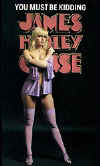 |
It is well known that most of Chase's novels were centered in the US, although Chase himself visited US quite late in his life. His output was based on encyclopedias and American slang dictionaries. This effort on the part of Chase was admirable, as he could have easily based his stories in Europe, of which, he had first hand experience. Chase tried to inject a distinct 'Brit' touch in the novels which he based in London. For instance, Mallory, Trusted Like The Fox, Mission to Venice, Mission to Siena, The Paw in the Bottle, and Chase's own semi - autobiographical, More Deadly Than The Male. The language, food habits, behavior of the London police, the legal system - all had a distinctive touch, when the novels had European locales. In general, the villains were not quite bloodthirsty, as compared to their American counterparts. In complete contrast, the majority of the novels, based in the US, had harsh American slang, tough mobsters and vicious, ruthless villains.
To make up for his lack of first-hand knowledge of US cities, Chase created fictional locations like Paradise City and Orchid City, supposedly on the Florida coast. Several novels were based in these cities and most of them were masterpieces. As for the authenticity of the locales portrayed, perhaps a reader actually based in Florida will be able to comment better!! However, Chase did try his level best to inject authenticity, right to the cultivation of oranges to the teeming hippies in his plots. However, Chase did not have a readership in the US and his books are still not widely available there. Chase also based a few of his novels in the far east, e.g., A Coffin from Hong Kong, You Have Yourself A Deal and A Lotus For Miss Quon, based on his own impressions during a personal visit in 1960. A Lotus For Miss Quon. was an outstanding piece of work by any standards.
Why was Chase relatively unknown in the US, while immensely popular in countries like France, Japan, Russia, some African and Latin American countries and India? Other than the original English versions, translations were also available in these countries. It is also widely accepted that (1) these translations were of poor quality and (2) some of these 'translations' were not of Chase's novels at all!! In fact, all sorts of books were translated / written afresh, slapped with a cover of a semi-nude woman and embellished with the magical name JAMES HADLEY CHASE to ensure their sale!! This is another enigma.
Critics brush aside this phenomenon by stating that in these countries, the readers were not in a position to know whether the locales, language, slang etc in the novels were genuine or not. Hence they could digest Chase's errors in portrayal of US culture. This is highly debatable.. An average reader would not be bothered whether Chase depicted Florida accurately or not, or whether his American slang was erroneous or authentic. A reader would admire the tight plots, story-telling, characterization, and of course, the nail-biting suspense and stupendous speed of narration. For a geography lesson on Florida or details on American slang, a person would pick up appropriate encyclopedias and not the novels of Chase!! Another idea is that in the US, there were umpteen authors of the same genre, writing novels and stories in pulp magazines, which were also available in Britain. During World War II, the supply of such 'fiction' to Britain diminished and readers had to make do with the 'local' writers specializing in the same genre (read: Chase). Again, this point is highly debatable. Because such premises my be true or partially true for the UK, but not equally applicable to diverse countries like India or France. And more importantly, Chase's popularity continued well beyond World War II, and continues even today.
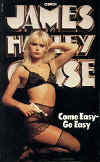 |
 |
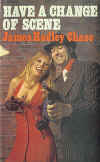 |
 |
Chase's principal characters have already been described elsewhere in this website. Chase's mythical creation, Paradise City (see above), and its principal characters, Capt. Terrell and Detective Tom Lepski were, perhaps, the most endearing and enduring characters developed by Chase. They appeared in several plots over a period of twenty years, till his last novel, Hit Them Where It Hurts (1984). Some of the novels included, Well Now My Pretty, There's a Hippy on the Highway, Believed Violent, and Want to Stay Alive??, The characters of Paradise City evolved over the years, and Lepski and Jacobi even got promoted. Lepski's character was also developed, and was evidently a favourite of Chase. An element of comedy was also introduced by Chase, against the backdrop of sexual violence and murder, depicted in the main plot. Lepski's arguments with his wife, Carol (a cousin of Terrell's wife), as well as his antics, gave humorous relief in many gory novels. Lepski was also the main protagonist in novels like You Must Be Kidding and Try This One For Size.
Chase developed an equally deadly villain, Herman Radnitz. The sinister Radnitz first featured in This is For Real (1965), as a billionaire, having a gory past, and stakes in shady international deals involving high finance. Actually Radnitz was Henrich Kunzli, who, during WW II, had contracts with the Nazi and Japanese governments, for the manufacture of soap, fertilizers and gun powder, from the teeth and bones of millions of murdered POWs in concentration camps. In This is For Real, Radnitz hires Mark Girland (see below), ex-CIA agent, to retrieve the papers incriminating him with the Nazis. However, the maverick Girland hands over the papers to the CIA, based at Paris. It is not sure why Radnitz could not be nabbed, even after his real identity was revealed, and he was to appear in several subsequent novels of Chase, in his most sinister and blood-thirsty roles, especially in Believed Violent (1968), You Are Dead Without Money etc. Believed Violent also saw the emergence of Lu Silk, a one-eyed professional assassin in Radnitz' payroll. Silk finally met his end in Consider Yourself Dead (1978). Radnitz subsequently got a replacement for Silk in Try This One For Size.
Several minor characters like Corridon, Malloy, Micklem and Fenner, appeared in few novels and disappeared. What made Chase develop a character and discard him? It may never be known. Chase's only female protagonist was Helga Rolfe, who appeared in no less than four novels. First introduced in An Ace up my Sleeve (1971), Helga was the beautiful, sexually-starved wife of billionaire, Herman Rolfe and ex-lover of Jack Archer. In fact, she married Rolfe, on Archer's suggestion. However, Archer and Helga later quarreled and Archer's subsequent attempts to swindle the Rolfes, formed the basis of the trilogy, consisting of The Joker in the Pack (1975) and I Hold the Four Aces (1977). The novels concentrated on Helga's sexual frustrations and her acumen for high finance; none of the novels had any gore.
Although Chase's motto appeared to be 'crime or illicit sex doesn't pay', neither the Radnitz nor the Helga series reached their logical conclusions, indicating, perhaps, that according to Chase, crime or illicit sex did pay, only and only if the persons involved in such activities were billionaires.
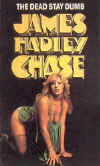 |
 |
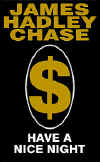 |
 |
The time periods can themselves be subdivided into (1) the time / period setting of the novel and (2) the time of writing the novels themselves. The list of Chase's works, together with their approximate time of publication has already been detailed elsewhere in this site. Chase set off with writing novels in the style of the tough American school, by writing No Orchids For Miss Blandish (1939). He continued till 1946, slowly inching towards to his predilection for depicting greedy, wanton women. In a sudden turn of events i.e. World War II, Chase produced Trusted Like the Fox (1946). WW-II and the post-WW scenario appears to have had a profound effect on Chase's writings and he produced master pieces like Mallory(1950) and Why Pick on Me? (1951).
The next twenty five years saw the GOLDEN PERIOD in Chase's output, with hard-hitting novels starting from Strictly For Cash (1951) to So What Happens To Me? (1974). Each novel was simply stunning, with tight original plots, hard action, sultry sex and plenty of double takes. The Cold War of the sixties inspired Chase to produce the Mark Girland series (1965 - 69), as well as classics such as Believed Violent (1968).
Post-1974, with Chase reaching the age of 68 years, the 'thriller maestro of the generation' seemed to be mellowing down. Novels such as Believe This - You'll Believe Anything (1975) and Not My Thing (1983) saw the 'bloodless' genre emerging, with more emphasis on elaborate dishes and spreads, rather smutty sexual descriptions, inane comedy with double innuendoes and a somewhat flippant, condescending attitude, especially towards non-whites. However, even during this 'slack' period, Chase managed occasional masterpieces like Consider Yourself Dead (1978) and We'll Share a Double Funeral (1982) .
 |
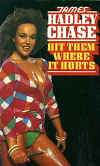 |
 |
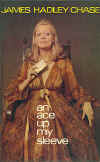 |
The story lines of Chase's novels were generally confined to (1) Robbery (2) Murder / Revenge (3) Insurance Fraud (4) Organised Crime (5) Lust / Violent Passion and (6) Espionage. Often, one or more of the above would be combined to form a composite but tight story line / plot. Generally, a violent passion for a wanton woman formed an important thread in most novels, leading to murder / robbery / insurance fraud. A list of novels, together with their genre, storylines and brief comments has already been described elsewhere in this site. A short synopsis of each novel can be had by clicking on the name of the novel and needs no description here. Chase also produced some 'bloodless' plots like Eve, Just A Matter of Time, You Must Be Kidding, Have A Nice Night and Not My Thing. Besides these, all the Helga Rolfe stories were without gore.
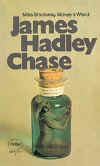 |
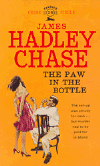 |
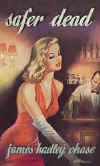 |
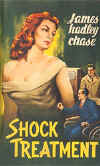 |
|
Quite surprisingly, Chase produced a short story, The Mirror in Room 22 and two full-fledged novels, Make The Corpse Walk and The Joker In The Pack with supernatural overtones. While the short story had a 'trick' ending - it was not clear whether Room 22 in the Air Force Officers' Mess was actually haunted or not, both the novels above had distinct elements of voodoo thrown in. Similarly, Miss Shmway Waves a Wand had elements of magic, interspersed with black comedy - definitely not the usual Chase fare. The plot and the theme itself was so unusual and wacky that it was indeed difficult to identify Chase as the author of the novel!! Nonetheless, the novel has its own fan following and has been the subject of two movies. Other short stories credited to Chase have been published in an anthology, Get A Load Of This, described elsewhere.
|
 |